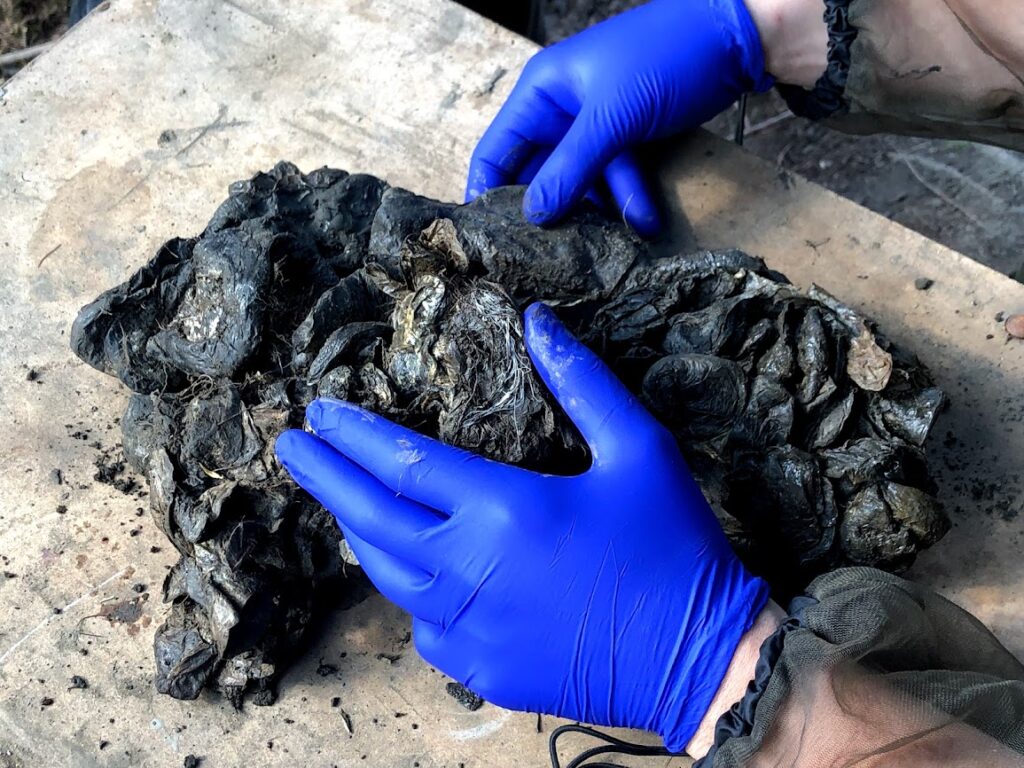Mereghetti analyzes ‘time capsules’ from last ice age
Alessandro Mereghetti has 59 time capsules from Siberia that will give insights into which animals lived there more than 20,000 years ago, as well as what plants they ate and how they interacted with the landscape over millennia.
These time capsules from the Siberian permafrost are coprolites. Also called fossilized feces.
“Poop is a time capsule,” says the Ph.D. student in Ecology and Environmental Sciences at the University of Maine Climate Change Institute (CCI). He estimates some of the fossilized feces are 20,000–28,000 years old and others are 40,000–50,000 years old.
Radiocarbon dating (a method to determine age), DNA testing and other analyses are being conducted on the fossilized dung, which is from an area where a well-preserved dead lion cub recently was unearthed from permafrost.
Mereghetti and his collaborators have found a branch and a piece of a flower inside a piece of the fossilized dung.
By examining the coprolites, pollen, remains of previously living plants, fossilized plant tissue, and ancient DNA, it’s possible to reconstruct the diet and behavior of extinct Arctic megafauna with unprecedented accuracy.

Understanding “past ecosystems to inform mitigation of climate change and conservation for a better future” is a goal, he says.
Mereghetti was awarded the Geological Society of America’s Charles A. and June R.P. Ross Research Grant for his project titled “Megaherbivores niche partitioning in Pleistocene Beringia.”
Megaherbivores are enormous plant-eating animals that weigh more than 2,200 pounds, such as woolly mammoths, woolly rhinos, elephants and bison.
The Pleistocene Epoch began about 2.6 million years ago and continued until about 11,700 years ago. During this most recent ice age, glaciers covered much of Earth.
And Beringia was a land bridge that connected Asia and North America until about 11,000 years ago. Now, it’s a 4 million-square-mile subcontinent underneath the Bering Strait. The National Park Service describes it as an ancient crossroad vital to understanding Earth and human history.
In 2019, Mereghetti collected about 32 coprolites in Siberia. The Academy of Sciences of the Republic of Sakha gave him the rest.
“It’s an unprecedented amount of poop all from the same area,” he says. The remains will shed light on what plants and animals were on the landscape, what animals ate and how the animals lived and divided space and resources.
When Mereghetti was in Siberia, a well-preserved bison and fox were found in the permafrost.
CCI paleoecologist Jacquelyn Gill learned of the fossilized feces on her expedition in Siberia, which was funded with an $800,000 National Science Foundation CAREER grant she earned to explore “Environmental Change and Extinction on the Mammoth Steppe.”
The mammoth steppe, in the Arctic belt in Beringia, stretched across Siberia, Alaska and Canada’s Yukon. Its diverse ecosystem once resembled a cold-weather version of an African savanna.
During the last ice age, grasslands that supported woolly mammoths and bison covered large swaths of the Arctic. But by 10,000 years ago, this habitat — the mammoth steppe — had disappeared. So, too, had the large mammals who lived there.
Gill, who is Mereghetti’s adviser, is examining whether the large animal “extinction was a cause or an effect of habitat loss.” She’s reconstructing ecological prehistory to establish the timing and nature of extinction, environmental change and habitat loss.
“Herbivores remain some of the most threatened animals today, so understanding the ‘Serengeti of the ice age’ can help in the management of Earth’s largest animals today, and may provide insights into the role native grazers play in a warming Arctic,” she wrote.
Gill’s work takes place in several Arctic locations, including Wrangel Island Reserve (the last known location of woolly mammoths on Earth) and Pleistocene Park in Siberia, where Sergey Zimov and Nikita Zimov are working to restore the mammoth steppe ecosystem to mitigate climate change. It’s home to reindeer, Yakutian horse, moose, bison, musk ox, yak, Kalmykian cows and sheep.
Mereghetti earned his master’s degree in biodiversity and evolutionary biology and his bachelor’s in biological sciences at the Università degli Studi di Milano in Italy.
“There’s a treasure trove of fossils and records in the Arctic,” he says, adding it’s urgent to locate them now: The permafrost is melting, and when it melts the fossilized feces will decompose.
Accessing the information stored in these time capsules will improve understanding of the Siberian landscape and how it changed 25,000–50,000 years ago, as well as advance conservation efforts for a better future, Mereghetti says.
The Charles A. and June R.P. Ross Research Fund is part of the Geological Society of America Foundation. It supports research grants to study rock layers, fossils, and the distribution of ancient plants and animals and their relation to ancient geographic features with the intent of understanding plate movements, past sea-level events, and paleoclimates.

